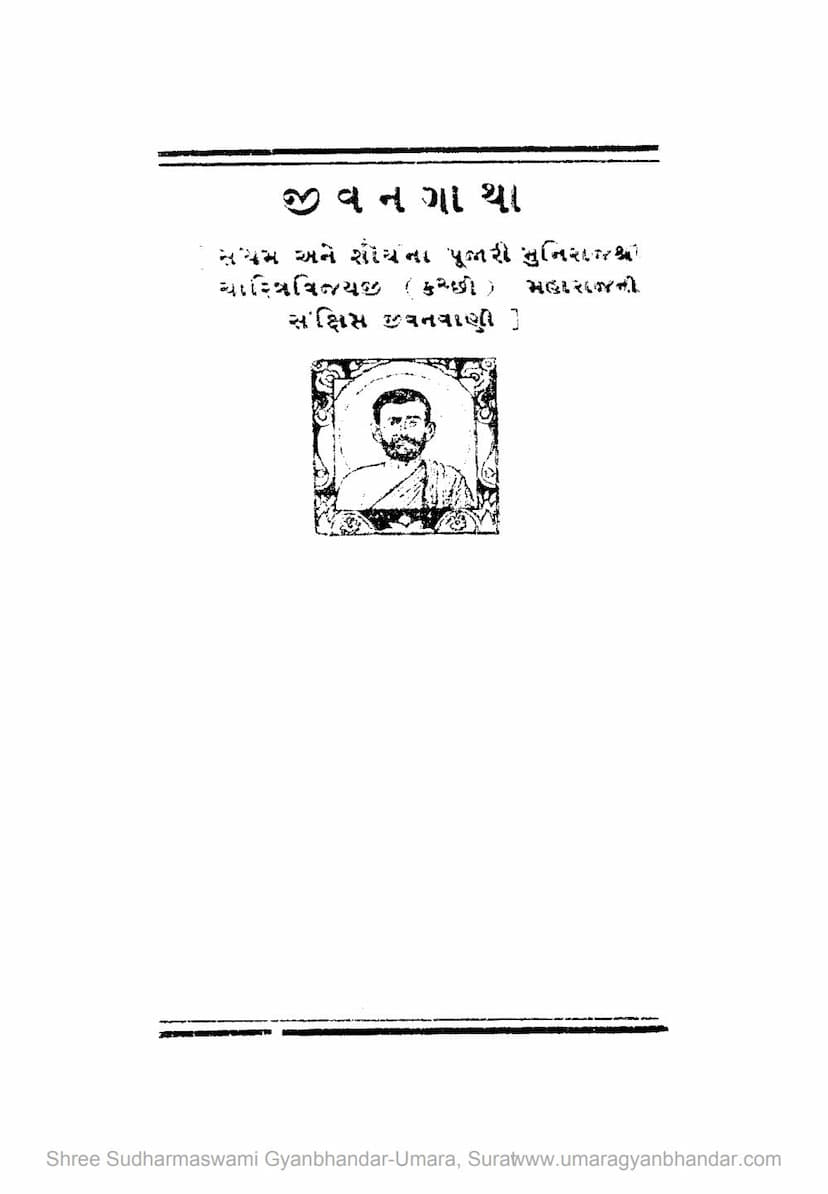Sanyam Ane Shouryana Pujari Muni Shree Charitravijayji (Kutcchi) Maharajni Jivangatha
Added to library: September 2, 2025

Summary
Here's a comprehensive summary in English of the Jain text "Sanyam ane Shouryana Pujari Muni Shree Charitravijayji (Kutcchi) Maharajni Jivangatha" by Jaybhikkhu, based on the provided pages:
This biography, "Sanyam ane Shouryana Pujari Muni Shree Charitravijayji (Kutcchi) Maharajni Jivangatha" (The Life Story of Muni Shree Charitravijayji (Kutcchi) Maharaj, Worshipper of Restraint and Valor), authored by Jaybhikkhu, chronicles the life and extraordinary deeds of Muni Shree Charitravijayji. The book portrays him as a spiritual leader who, while free from high monastic titles, exemplified the highest principles of Jainism. He is described as a devotee of truth, courage, and purity, a staunch opponent of injustice, and a true follower of the tenets of Syadvada and the purity of outcomes. His life is presented as an ideal for the current era, highlighting his dedication to humanity and selfless service, underpinned by rigorous asceticism.
Key events and aspects of Muni Shree Charitravijayji's life highlighted in the provided pages:
-
Heroic Rescue during a Flood: The narrative begins with a dramatic account of a severe flood. Muni Shree Charitravijayji, witnessing the imminent danger to the people, took immediate action. He organized the rescue efforts, using ropes from book chests to create makeshift lifelines, saving hundreds of people and animals from the raging waters. This act of selfless bravery required him to use the monastery's resources, including its clothing stores, to provide for the rescued. His actions were so remarkable that the local administrator, Major Strong, was deeply impressed and compared him to a "Jain Hollywood" figure, praising his courage, strength, and dedication. The Times of India also featured this event, lauding his heroic rescue.
-
Humble Origins and Early Life: The biography then delves into his background, tracing his lineage to the Vesa Oswal clan in Kutch. He was born Dharshi on a significant night in the Asho month of Vikram Samvat 1940. His childhood was spent in the village of Patri, where he grew up robust and fearless, engaging in farming and outdoor activities. He was known for his bravery from a young age, as illustrated by an anecdote where he bravely faced the consequences of an attempted theft of crops rather than admitting guilt. He also demonstrated courage by felling a fearsome acacia tree believed to be haunted, which had terrified villagers for years.
-
Journey to Mumbai and Personal Trials: At the age of fourteen, Dharshi moved to Mumbai to work and learn business. He was successful, becoming a partner in a business and later bringing his mother and siblings to join him. However, his life was marked by profound personal losses. He lost his mother and sister to a plague. He also faced immense personal suffering due to a severe illness with multiple abscesses. During this time, a friend's advice to take refuge in Dharma and vow to become a monk if he recovered proved pivotal.
-
Ascetic Life and Philosophical Evolution: Upon recovery, Dharshi renounced worldly life and was initiated as a Jain monk, taking the name Dharmasingh Swami. However, his intellectual curiosity and quest for truth led him to question certain interpretations and practices within his sect (Sthanakvasi). He found himself drawn to the practices of the Achalgachh sect and began visiting their temples, which caused friction with his own sect. His deep contemplation led him to a profound spiritual dream.
-
Transition to Charitravijayji and Path to Renowned Scholarship: His commitment to truth and his independent thinking ultimately led him to seek a new path. He was formally initiated into the Achalgachh sect and renamed Charitravijayji, signifying his victory in adhering to righteous conduct. He then embarked on a rigorous study of Jain scriptures, traveling to places like Kashi for advanced learning. His scholarship and dedication were recognized, and he continued to travel, spreading the teachings of Jainism and engaging in social reform.
-
Advocacy for Education and Social Reform: Muni Shree Charitravijayji was a strong proponent of education and social welfare. He was instrumental in establishing a Jain Sanskrit and Prakrit Pathshala (school) in Palitana, driven by his vision to provide education for Jain children and preserve Jain heritage. He also actively addressed social issues such as poverty and the plight of orphaned children, initiating programs to support them. His efforts extended to resolving disputes within the community and promoting unity.
-
Defense of Religious Sites: The text also highlights his courageous defense of Jain pilgrimage sites from desecration and disrespect by certain individuals, even facing physical threats. He demonstrated unwavering resolve in protecting the sanctity of these holy places.
-
Dedication and Sacrifice: Throughout his life, Muni Shree Charitravijayji displayed immense dedication and made significant sacrifices for his spiritual path and for the betterment of the Jain community. He faced personal hardships, societal opposition, and health challenges with resilience and unwavering commitment to his principles.
-
Later Years and Legacy: He continued his missionary work in Kutch, his homeland, focusing on spiritual upliftment, education, and social reform. He was known for his ability to inspire and unite communities. Sadly, his life was cut short by the influenza epidemic, but his legacy endured. The institution he founded in Palitana continued to thrive, becoming a testament to his vision and dedication. His disciples carried on his work, continuing his mission of spreading Jain teachings and promoting social welfare.
The book emphasizes the values of restraint (Sanyam), valor (Shaurya), truth, selfless service, and the pursuit of knowledge as central to Muni Shree Charitravijayji's life. The concluding sections also offer a critical reflection on the current state of the Jain community, urging for greater action, education, and unity to uphold its rich heritage and address contemporary challenges.